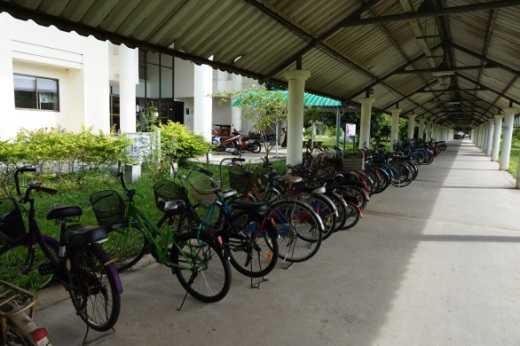Guidelines for Development and Promote Bicycle Use in Green University:Walailak University, Nakhon Si Thammarat Province
Main Article Content
Abstract
Research aimed to analysis the cycling attitudes and behaviors in university area, to discover condition and limitation of physical bicycle way existing, to improve the existing bicycle way in practical use, to be guideline in term of improving a bicycle route system in the green university. This research used four different methods of data collection. The first, a literature review, the second, by analyzing existing university documents, the third, a questionnaire and finally a survey and open forum for sharing ideas and opinions. These research methods were carried out within two groups. The total of 47 staffs and 338 students were chosen through stratified random sampling. Descriptive statistics were used to analyze the data collected from the Division of land and building as well as from the questionnaires and surveys. In-depth comments were collected from knowledge sharing activity.
The research found that there are four ways of improving the current system which are as follows: 1.) A set of rules or guidelines aimed at encouraging bicyclists to go in the same direction. 2.) Long term planning conducted with input from users. 3.) The new system should be designed to meet the needs of everyone. 4.) There should be a clear divided land use according to the public transit system.
Downloads
Article Details

This work is licensed under a Creative Commons Attribution-NonCommercial-NoDerivatives 4.0 International License.
All material is licensed under the terms of the Creative Commons Attribution 4.0 International (CC-BY-NC-ND 4.0) License, unless otherwise stated. As such, authors are free to share, copy, and redistribute the material in any medium or format. The authors must give appropriate credit, provide a link to the license, and indicate if changes were made. The authors may do so in any reasonable manner, but not in any way that suggests the licensor endorses you or your use. The authors may not use the material for commercial purposes. If the authors remix, transform, or build upon the material, they may not distribute the modified material, unless permission is obtained from JARS. Final, accepted versions of the paper may be posted on third party repositories, provided appropriate acknowledgement to the original source is clearly noted.
References
Bureau of Traffic Safety. (2015). Guild for development of bicycle facility. Retrieved January 3, 2016, from http://ooh5.go.th/CA/CA14.pdf.
Chaowarat, P., & Piriyakarnnon, M. (2014). Promoting walking and cycling (Mahasarakrm University Karmreang campus). The 2nd Thailand Bike and Walk Forum, 1(1), 58.
Charmondusit, K. (2015). Eco - University. Retrieved September 18, 2017, from http://www.op.mahidol.ac.th/oppe/downloads/policy.pdf.
Chutima, K. (2015). 8 Things top bike cities have done to promote safer cycling. Retrieved March 5, 2016, from http://www.thaicyclingclub.org/.
Kasetsart University. (2017). University strategic plan, Kasetsart University 2017-2028. Retrieved September 18, 2017, from http://council.ku.ac.th/wp-content/uploads/file/council_12years.pdf.
Panswad, T. (2012). Lessons learned from the European city bikes. Retrieved October 2, 2015, from http://www.thaicyclingclub.org.
Silpcharu, T. (2008). Research and analysis of statistical data, with SPSS (9th ed.). Bangkok: Business R and D.
Trakulvech, L. (2008). A study on the application of public-use bike system in Kasetsart University, Bangkhen Campus. Bangkok: Kasetsart University.
Transit Oriented Development institute. (2015). Transit Oriented Development. Retrieved March 10, 2017, from http://www.tod.org/.
Walailak University. (2012). Accident report 2012-2014. Nakhonsithammarat : Division of Property and Supplies, Walailak University.
Walailak University. (2014). University strategic plan, Walailak University 2014-2016. Nakhonsithammarat: Division of Planning, Walailak University.


